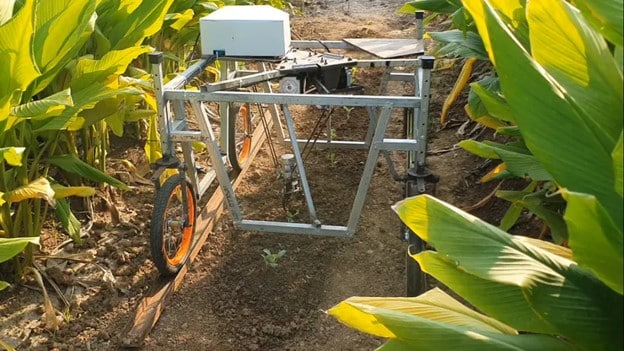Kevin Patel and Nihar Chaniyara grew up among rural India’s herbicide-treated crops of corn, sugarcane and mangos. Today they cultivate organics with data, vision models and GPUs.
Twenty-somethings from farming families, they developed Nindamani, an AI-driven, weed-removal robot prototype that took top honors at the recent AI at the Edge Challenge on Hackster.io.
Hackster.io is an online community of developers, engineers and hobbyists that drew more than 2,500 registrants and 80 submissions from 35 countries for the NVIDIA-supported contest.
The students from sun-kissed Gandhinagar — in India’s western Gujarat Province — are among 10 winners in the competition that called on participants to use the Jetson Nano Developer Kit.
Clever engineers, Patel and Chaniyara designed multiple iterations of their mechanical weeding arm for metal fabrication. For its brains, they trained Mask R-CNN using cloud GPUs to distinguish weeds from plants. Mask R-CNN is a deep neural network that separates different objects in images or videos. Jetson Nano does inference.
Late nights of work paid off. The Nindamani project landed first place in the autonomous machines and robotics category.
“About 90 percent of my relatives are in the farming sector, so you can understand how I’m relating to this problem,” Patel said.
AI Versus Herbicides
Their home region produces rice, cotton, potatoes, cauliflower and other staples. Yet farmers there — like elsewhere — face labor shortages and herbicide concerns.
Patel and Chaniyara surveyed more than 8,000 farmers in and around the area for input on the problems and the kind of solutions they need.
“They need this kind of AI and some kind of robotic automation technology so they can solve the labor problem and the chemical spraying,” said Patel. “This can also help yield and profit.”
Swarm Farming Wave
The Nindamani prototype joins a wave of so-called swarm farming efforts in robotics to harvest AI for efficiency and sustainability. For India’s vast farms that feed nearly 1.4 billion people, advances in agriculture technology matter.
Swarm farming robots are designed to tackle tasks with a “swarm” of multitasking robots — sprayer, weeder, seeder, harvester, hauler — as modular machines. They’re developed to stay busier than traditional single-purpose tractors, consume less energy and cost less.
Nindamani is in its early days as a prototype, but the idea is to also lower the costs of machinery for farmers who might otherwise turn to herbicides.
“Weeding is very tedious work, and that is where the automation and the robotics come in,” said Chaniyara.
